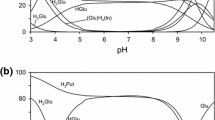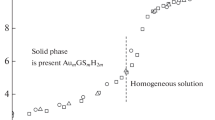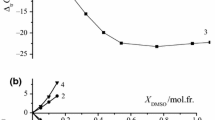Abstract
Combined pH-metric and spectrophotometric investigations on the complex formation equilibria of CuII with guanylurea (H2 1NC(=O) 2NH.C(=3NH) 4NH2), hereafter, GuH, in the absence and in the presence of glycine (GlyH), in aqueous solution indicates variety of binary and mixed-ligand complexes: Cu(Gu)+, Cu(Gu)(OH); Cu(Gu)2, Cu(Gu-H)(Gu)−, Cu(Gu-H) 2−2 , Cu(Gu-H)(Gu-2H)3−; Cu(Gly)+, Cu(Gly)(OH); Cu(Gly)(Gu); Cu(Gly)(Gu-H)−, Cu(Gly)(Gu-2H)2−; (Gly)Cu(Gu)Cu(Gly)+, (Gly)Cu(Gu-H)Cu(Gly) and (Gly)Cu(Gu-2H)Cu(Gly)−. At pH < 6, guanylurea anion (Gu−) acts as a [(C=O), 3N−] or [=]NH, 3N−] bidentate ligand and above pH 7 it is transformed through a coordination equilibrium into a (=1N−, =3N−) bidentate ligand, similar to biguanide dianion. Occurrence of dinuclear complex species, (Gly) Cu(Gu)Cu(Gly)+, in the complexation equilibria, indicates bridging double bidentate [(1NH2, 3N−), (C=O, 4NH2)] and/or [(1NH2, 4NH2), (C=O, 3N−)] chelation by Gu− ion in an isomeric equilibrium. Above pH 6·5, the dinuclear complex decomposes mostly to the mononuclear species, Cu(Gly)(OH) and Cu(Gu)(OH) and only partly deprotonates to (Gly)Cu(Gu-H)Cu(Gly) and (Gly)Cu(Gu-2H)Cu(Gly)−. Electronic spectral shifts, with change of pH have been correlated with the possible modes of coordination of guanylurea species.
Similar content being viewed by others
References
Ray P 1961 Chem. Rev. 61 313 and references there in
Mitra A and Sen D 1972 Inorg. Nucl. Chem. Lett. 8 793
Babykutty P V, Prabhakaran C P, Ananteraman R and Nair C G R 1977 J. Inorg. Nucl. Chem. 39 913
Bremner C A and Harrison W T A 2002 Acta. Cryst. 58 254
Dutta R L 1960 J. Indian Chem. Soc. 37 499
Roy Barman T and Mukherjee G N 2006 J. Chem. Sci. 118 411
Kolthoff I M, Sandell E B, Meehan E J and Bruckenstein S 1967 In Quantitative chemical analysis (London: Macmillan), 4th edn, ch. 41
Schwarzenbach G and Biederman W 1948 Helv. Chem. Acta 31 331
Sayce I G 1968 Talanta 15 1397; Sayce I G 1970 Talanta 18 653; Sayce I G and Sharma V S 1972 Talanta 19 831
Perrin D D 1979 in Stability constants of metal ion complexes: Part B, Organic Ligands, IUPAC Chemical Data Series No. 22 (Toronto, Sydney, Paris, Frankofurt, Oxford, New York: Pergamon Press) pp 14, 38, 73
Irving H M and Rossotti H S 1954 J. Chem. Soc. 2904
Harned H S and Owen B B 1958 The physical chemistry of electrolytic solutions (New York: Reinhold) pp 66, 662, 713–756
Wolleym E M, Hurkot D G and Hepler L G 1970 J. Phys. Chem. 74 3908
Irving H M, Mills M G and Petit L D 1967 Anal. Chim. Acta. 38 475, 163
Freeman H C 1973 In Inorganic biochemistry (ed.) G L Eichhorn (Amstardam: Elsevier) vol. 1, ch. 4, p. 121 and references there in
Sigel H and Martin R B 1982 Chem. Rev. 82 385
Billo E J 1974 J. Inorg. Nucl. Chem. Lett. 10 613
Author information
Authors and Affiliations
Corresponding author
Rights and permissions
About this article
Cite this article
Barman, T.R., Mukherjee, G.N. Coordination equilibria in the complex formation of guanylurea with CuII: Formation and stability of binary CuII-guanylurea and ternary CuII-guanylurea-glycinate complexes. J Chem Sci 120, 377–390 (2008). https://doi.org/10.1007/s12039-008-0061-9
Received:
Revised:
Published:
Issue Date:
DOI: https://doi.org/10.1007/s12039-008-0061-9




